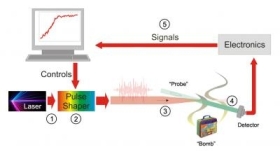Apr 15 2010
The Los Alamos National Laboratory and the Princeton University researchers have successfully demonstrated the functioning of the Optical Dynamic Detection (ODD) system that can detect chemical explosives like nitroglycerin in a package.
 Representation of Optimal Dynamic Detection
Representation of Optimal Dynamic Detection
The ODD project was initiated during the 2008 summer when these researchers discussed the proof of ODD concept with the Science and Technology Directorate (S&T) of the Homeland Security. Satisfied, the SIT awarded a contract to fund the proof of concept research project to the two labs. Followed by several stages of successful testing the researchers were able to prove the concept after 18 months. The research team now aims to create a portable ODD prototype for field testing within three years. The ODD system offers a novel and improved method for the detection of explosives.
A bomb technician uses the ODD to focus an unprocessed laser pulse on to a dubious package that is likely to contain a particular explosive. This pulse is made to pass through an electro-optical type of filter. The pulse gains clarity when it is bent while passing through the lenses, followed by reflection due to mirrors and amplification by chips. The filter is able to reshape the pulse of the laser whenever the laser is tuned to a new frequency by the technician. The laser pulse undergoes an amplitude transformation during the process of bending, reflection, and electronic processing of the pulse.
When this shaped pulse strikes the chemical environment surrounding the package, for example a lunch box, the chemical material’s energy state is excited, resulting in an energy signature. This signature is accurately defined as the laser pulse is also defined well. At this stage, another laser known as the analyzing probe is focused on to these excited molecules for measuring their spectrum. The probe beam is then made to pass through an electro-optic type of detector that is positioned on the package’s other size.
The final shape of the pulsed laser is stored and examined. If the signature resembles that of a chemical explosive, the bomb technician will be able to attribute the signature positively to the chemical explosive material that was responsible for its emission, which could be found in the zipper or the fabric of the package.
The ODD is able to decrease background signals interfering with the potential bomb detection process. The pulse return signal is amplified during the bomb detection process for illuminating the threat. This system provides better control during the bomb detection process due to its accuracy, thus saving precious lives and time. S&T’s program manager at the Explosives Division of the Department, Eric Houser compares the bomb detection and evaluation process to finding a needle inside a stack of hay, and adds that the ODD helps to expose this needle.
The existing bomb detection process is based on spectroscopy that utilizes the color spectrum for shedding light on the makeup of a suspicious looking package, say a lunchbox. Spectroscopy is able to visualize a microscopic residue at the outer layer of the lunchbox that could offer revealing clues relating to the content inside the box. However, the spectroscope cannot view through the box, since it utilizes only visible light.
This method involves beaming a laser on to the suspicious package by the bomb squad, followed by comparison of the ensuing optical laser finger print or the reflected light signature with a reference range of known signatures representing chemical compounds like nitroglycerin. This compound, if present in the box, is likely to be present as residue.
However, this method has two issues. The first is related to the distance. Spectroscopy is likely to prove very dangerous as most threat detection techniques stipulate that the detector or the person be located in the vicinity of the bomb. Second, spectroscopy-based methods that are based on the reflected light are not selective or sensitive enough, more so in real environments when signatures from chemical compounds are likely to be contaminated or overlapped.
Light signatures should be considered as finger prints. It is not very difficult to trap a fingerprint signature from a clean surface. However, under real life conditions, surfaces are not clean and contain ink stains, grease, and dust, resulting in the formation of minute deposits consisting of different chemical compounds, each one having a particular opaque fingerprint. The detector has to be selective as well as sensitive for minimizing false alarms. Many of the limitations of spectroscopy-based methods are likely to be eliminated by the ODD technology. Houser explains that the ODD is like a quantum control technique that is applicable to the detection of the explosives.